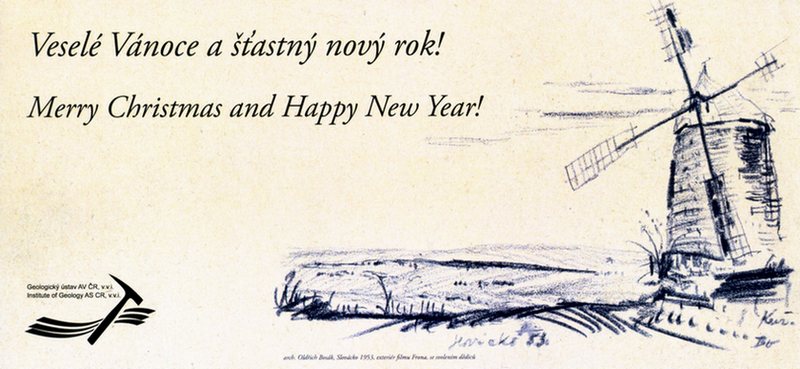News archive
News older than one year.
Research Reports 2015
Research Reports 2015 - the annual report on scientific activities of staff of the Institute of Geology – has been newly published.
Straddling the range from gold grains to Moon dust: automated scanning electron microscopy
Do you need to support mineral prospection by automated mineralogy and artificial intelligence? Do you need to build a platinum concentrator? Do you need to find a particular dust particle in a million? Do you need to assess the risk of environmental pollution? Or to mix up a bucket of Moon dust? In all these tasks, automated scanning electron microscopy proves useful by integrating millions of individual measurements.
Photogenic Science
Photographs taken by the staff of the Institute of Geology were successful again in the third run of the Photogenic Science contest. In the “Photogenic Science” category, the professional jury and the Academic Board awarded the 2nd, 3rd and 4th positions to photos “Dead mire” and “A world in a drop of water” by Jiří Sláma. In the “Scientists on photographs” category, the 2nd position was awarded by the professional jury to Michal Filippi for a photo named “On the bottom”. In addition, the following photos were selected for the semi-finals: “Dancers” and “Races in the rain” by Pavel Lisý, “Talking rocks” and “Burning fire” by Jiří Sláma and “Painting” by Michal Filippi. The honoured photographs will be included in the Calendar of the Academy of Sciences. Some other photos from the semi-final selection are being used in promotion materials of the Academy of Sciences. For the photos and additional information, click here.
A new popular-science book on the landscape evolution of the Křivoklátsko Protected Landscape Area
Two staff members of the Institute of Geology AS CR, Karel Žák and Václav Cílek, became authors of a new book on the landscape evolution of this nature-protected area. The book reviews landscape evolution since the oldest geological past until the present time (Křivoklátsko – The Story of the Royal Hunting Forest by K. Žák, M. Majer, P. Hůla, V. Cílek). The book was published with the financial support of the Central Bohemian Region in the Dokořán publishing house. The photos were taken during the launching ceremony of the book, which was held at the Křivoklát medieval castle on September 23, 2016.
Ladislav Slavík appointed secretary of the International Subcommission on Devonian Stratigraphy
RNDr. Ladislav Slavík, CSc. of the Institute of Geology CAS has been appointed a secretary of the International Subcommission on Devonian Stratigraphy ICS, IUGS. He has started his new term for the next four years (2016–2020) after the Meeeting of the International Commission on Stratigraphy that was held at the 35th International Geological Congress in Cape Town, South Africa in August 2016.
Toxic metals revealed to be absorbed by mycorrhizal fungi at plant roots
Jan Borovička and his co-workers have published a study on the accumulation of toxic metals and other elements in ectomycorrhizal roots of Norway spruce (Environmental Pollution, Impact Factor: 4.839). Their research was conducted in the Příbram area, subjected to long-lasting man-induced pollution from ore mining and processing. When compared to non-mycorrhizal tiny spruce roots and organic soils, concentrations of metals (cadmium and silver in particular) were significantly elevated in ectomycorrhizal roots. This phenomenon can be attributed to metal-binding capacity of fungal mycelia. These results support the hypothesis that mycorrhizal fungi may protect host plants against heavy metal toxicity in polluted environments.
Microbial precipitates in old iron ore mines (central Bohemia)
One of the preserved galleries in the former iron-ore mining district of Zdice (35 km SW of Prague) originated between 1950 and 1965. The iron-rich layer, Ordovician (460 million years) in age, was found to be of low thickness and low grade to be economic. The present study of the gallery is focused on presently forming secondary precipitates of iron and calcium compounds. It is likely that some of the precipitates are microbially induced, with a significant involvement of iron bacteria. Photo gallery.
Petr Štorch has been elected as a chairman of the International Subcommission on Silurian Stratigraphy
RNDr. Petr Štorch, DrSc. from the Institute of Geology CAS has been elected as a new chairman of the International Subcommission on Silurian Stratigraphy ICS, IUGS. He will take the helm for next four years (2016-2020) after 35th International Geological Congress to be held in Cape Town, South Africa in August 2016.
How much dust is there floating in the atmosphere? Up to five billion tons every year, a geologist says
Tomáš Hrstka, the current leader of the Atmospheric Dust Project of the Strategy AV21 programme, was invited to Czech Radio to talk (in Czech) about the present trends of this hazardous component in our everyday environment. At this occasion, he also mentioned a new technique which has been applied: fully automated, high-throughput analyses of element and mineral compositions applied to samples of dust deposits. Tomáš Hrstka has significantly contributed to the development of these techniques internationally.











